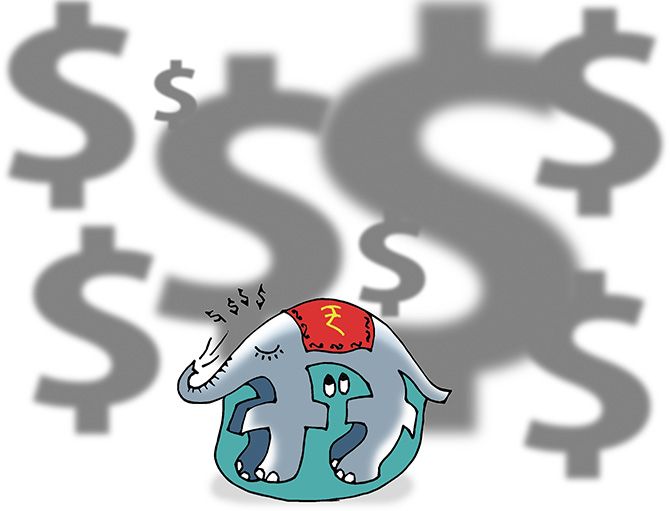‘For the RBI, it is also strategic to allow the rupee to over-depreciate, then come and buy the rupee, and benefit from its appreciation. Speculators who have driven the rupee too low then make losses,’ says Ashima Goyal.

A depreciating rupee and rising crude oil prices recently prompted the government to announce a five-point agenda to encourage dollar inflows.
It also plans to restrict certain non-essential imports.
Ashima Goyal, member, Prime Minister’s Economic Advisory Committee, tells Joydeep Ghosh that the Reserve Bank of India should target inflation and growth, not raise rates to defend the rupee.
Are the government’s measures sufficient to arrest the rupee's fall?
These are mostly measures that will take effect over time. But the announcement of the intent to take action, in itself, should soothe markets.
The rupee has now depreciated in excess of fair value and the realisation that firm action is around the corner should help it recover.
Since Indian firms have been starved of credit, making it easier for them to borrow abroad is helpful.
But short-term unhedged foreign debt can create more problems. The emphasis should be on addressing structural problems raising India’s current account deficit (CAD) rather than on financing it in risky ways.
What about import curbs on non-essential items? How would you classify such items, and does gold qualify?
Over the last 10 years, unfortunately, the Indian industry faced adverse macroeconomic and regulatory conditions while consumption has been stimulated. Growth in credit was largely in retail.
Some key government reforms have long-term benefits for industry but also have short-term costs. So, imports have grown faster than exports.
The recent rise in oil prices has aggravated the situation.
Therefore, some disincentives for luxury consumption items is probably justified as a short-term measure until issues facing domestic industry are addressed.
Non-essential items are those that do not contribute directly or indirectly to productivity. Some gold imports qualify as non-essential. But such measures must be undertaken carefully, so they do not add transaction costs or encourage black economy or run counter to World Trade Organisation rules.
Large-value import items should be identified and their domestic production encouraged; renewable power must be given a boost to reduce dependence on oil imports.
Should the rupee be allowed to find its own level?
Markets have a vital role in price discovery, but they tend to overreact. Sudden sharp changes in the rupee value do not help markets or exporters and have a number of adverse effects. Therefore, the RBI must intervene to reduce excess volatility. In 2011, the rupee sank when the RBI said it was unable to intervene.
Conversely in 2013, it recovered on the RBI’s firm backing.
One-way momentum can set in if the central bank disappears from the market in times of excess volatility.
But for the RBI, it is also strategic to allow the rupee to over-depreciate, then come and buy the rupee, and benefit from its appreciation. Speculators who have driven the rupee too low then make losses.
Can the rupee fall further?
It should reverse since the Rs 69-71/dollar band is currently consistent with a fair value of the rupee.
Given the RBI’s conundrum on the rupee, do you expect it to hike rates in October?
As an inflation-targeting central bank, the RBI should respond to expected inflation and growth, not undertake an interest rate defence of the rupee. Inflation has come in lower than its forecasts again.
Moreover, the RBI has a large number of other instruments available to smooth excess volatility of the rupee. It must learn from experience, draw on its institutional memory and adapt its response to the Indian context.
Since large inflows of last year over-appreciated the rupee, using some of the accumulated reserves to smoothen fewer inflows this year is acceptable. There have been outflows during past global risk-offs and turbulence from India, but they have always returned soon, given India’s growth prospects.
In 2013, one of the most effective measures in reducing the rupee’s depreciation was making dollar swaps available to oil marketing companies since it significantly reduced dollar demand. It will reflect poorly on the RBI’s capabilities if it is unable to reduce the impact of external shocks on the domestic cycle.
Should the Centre and states consider cutting tax on crude oil?
There is scope to cut state-level ad valorem taxes that rise with oil prices. Even at the Centre, since taxes were raised when oil prices fell, they should fall when oil prices rise in a counter-cyclical burden sharing arrangement, which would be seen as fair.
Arguments against a cut are the importance of discouraging oil consumption, which is polluting, and adds to the current account deficit. But Indian oil prices are already high enough to discourage consumption.
The tax cuts need not be large, but the State should not be seen as gaining from an oil price rise while imposing a double burden on the common man.
With rising CAD, can fiscal deficit be maintained at the budgeted level of 3.3 per cent of GDP?
When a government is committed to a target, as this one is, it can certainly be met. Higher growth and revenue buoyancy due to reforms should make meeting the fiscal deficit target possible without requiring too much reduction in productive expenditure.
Illustration: Dominic Xavier/Rediff.com.











